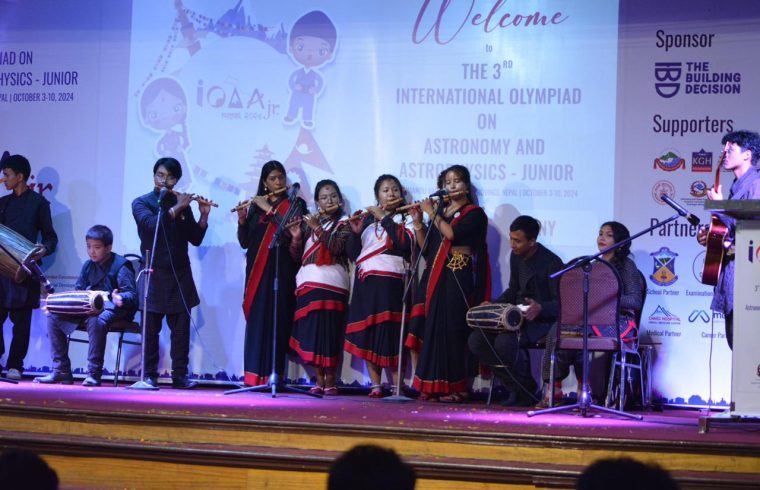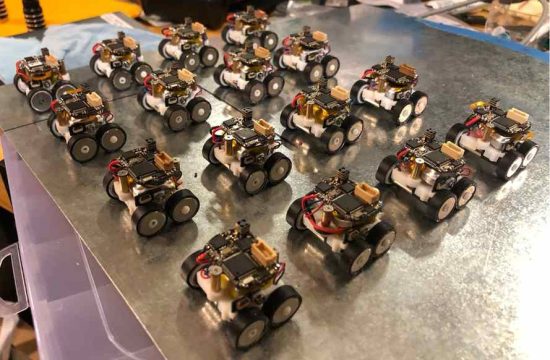Students from 19 countries, including Nepal, marched in the 3rd International Astronomy and Astrophysics Olympiad-Junior (IOAA-jr 2024), organized for the first time in Asia.

Kathmandu. The third edition of the International Olympiad on Astronomy and Astrophysics-Junior (IOAA-jr 2024) has started for the first time in Nepal. The International Olympic Committee (IOC) decided to organize IOAA-jr 2024 outside the European country six months ago.
Including Nepal, altogether nineteen countries, have participated in IOAA-jr 2024, which started Friday at St. Xavier’s School Godavari, Lalitpur District, one of the districts inside Kathmandu Valley.
In IOAA-jr 2024′, there are altogether 150 students, with team leaders participating from Bangladesh, Bulgaria, Canada, China, Colombia, Czech Republic, Estonia, Greece, India, Italy, Lithuania, Malaysia, Nepal, Romania, Sri Lanka, Sweden, Thailand, Ukraine and UAE.
Especially, this event, organized by Nepal Astronomical Society (NASO) and co-organized by the Ministry of Education, Science, and Technology along with the Ministry of Social Development of the Bagmati province Government, will become a milestone in not only Nepal but also in the world in astronomical advancement and future astronaut development.
Inaugurating the Olympiad, Anita Lama, Deputy Mayor of Budhanilkanth Municipality, said, “We were eager to welcome this program to Budhanilkanth Municipality, but this time we did not have such an opportunity.”
Deputy Mayor Lama, further expressed, I don’t want to missed to meet students coming from 18 countries, said in the program, “I came to encourage the youth rather than coming to the program with the thought of being the chief guest.”
Aniket Su, President of the International Astronomy and Astrophysics Olympiad (IOAA), said, “Nepal is the country where Gautama Buddha was born. Buddha said that peace, friendship, and happiness are important for life, therefore, I would request, at least, to make five friends on the occasion of the Olympiad.”
On the occasion of coming to Nepal, he requested the students to closely observe the art and culture of Nepal. IOC president Sule further encouraged the students to aim high in life by saying that Everest, the world’s highest peak, is in Nepal. He expressed his happiness that Italy was present at IOAA-jr for the first time.

Vijay Pratap Toppo, principal of St. Xavier’s School at Godavari said that we are happy to support this type of program for astronomical development in Nepal.
According to the Organizers, Professors, Researchers and Nepali astronomical experts working in the field of astronomy from different countries will play the role of observers in the program.
A performance of the ancient folk dance living goddess ‘Kumari’ inside the Kathmandu valley is one of the main attractions of the opening ceremony of IOAA-jr 2024. Also, a vibrant orchestra of traditional music of ethnic Newa culture was performed in IoAA-jr 2024.
The teams from 19 countries proudly paraded with their national flags during the ceremony of the 3rd IoAA-jr 2024 in Kathmandu.
Establishment of IOAA-jr 2024
Nepal is one of the founding members of the “International Astronomy and Astrophysics Olympiad-Junior” which was started in 2019 A.D. The first edition of IOAA-jr 2022 was organized in Romania and the second edition of IOAA-jr 2023 was organized in Greece.
According to NASO, the permission of IOAA-jr 2024 was granted by the International Astronomy and Astrophysics Olympiad Committee. NASO received permission on behalf of Nepal in the competition of various countries for the selection of the host organization of the third edition of IOAA-jr. “This is our golden opportunity to organize IOAA-jr 2024 for the first time in a South Asian country like in Nepal,” says Suresh Bhattarai, president of NASO.
In addition, Olympiad is a program to reveal the academic ability of the students, in which the academic and intellectual ability of the students is tested in a theoretical and practical way. After participating in this program, students will develop their astronomical observation skills.
In this program, there will be joining professors, researchers, and Nepali Astronomical experts working in the field of astronomy from different countries who will act as observers in the program, Suresh Bhattarai, president of NASO said.
Similarly, since 2014, NASO has been conducting the National Astronomical Olympiad every year in Nepal. In this ‘senior category’, students in the age group of 16 to 20 years studying from class 11 to 12 can participate.
NASO has been conducting the National Astronomical Olympiad of ‘Junior Category’ since 2019. Students under the age of 16 studying in classes 8 to 10 can participate in this category.
The selected students who get excellent results in the National Astronomy Olympiad will be allowed to participate in the International Astronomy and Astrophysics Olympiad. So far, Nepali students received 18 medals in the International Astronomy and Astrophysics Olympiad.









